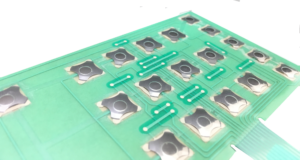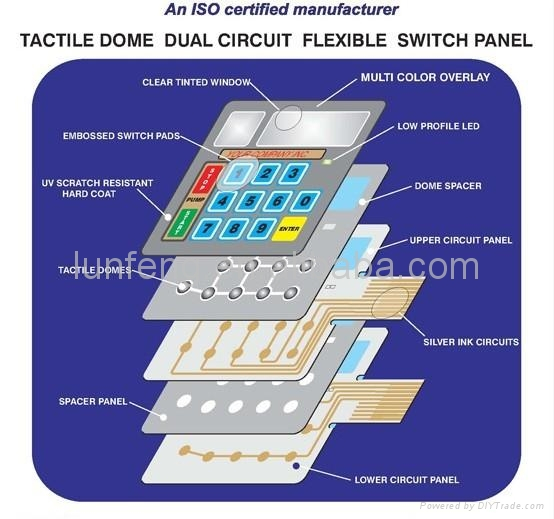Figure out How Membrane Switches Are Customized to Fulfill Particular Layout Requirements
Figure out How Membrane Switches Are Customized to Fulfill Particular Layout Requirements
Blog Article
The Ultimate Resource on Membrane Layer Changes: Design, Performance, and Applications
Membrane changes serve as an appealing crossway of design and performance, playing a crucial role in contemporary interface across various fields. This resource unpacks the crucial components that add to their effectiveness, consisting of graphic overlays and circuit traces, while also illuminating the mechanisms behind their stress activation. As we discover the diverse applications of membrane layer switches, it becomes noticeable that their flexibility and sturdiness are important in settings ranging from medical care to consumer electronic devices. Nonetheless, the nuances of their style and operational concepts might expose even deeper insights worth considering.

Comprehending Membrane Switches
Membrane switches are a kind of interface innovation widely used in various digital gadgets, characterized by their slim, flexible layout and performance. These switches include numerous layers that include graphic overlays, glue layers, and circuitry, enabling a efficient and compact user interface for individuals. They can be found in devices, medical devices, and commercial control panels, supplying a trustworthy technique for individual interaction.
One of the key benefits of membrane buttons is their ability to withstand pollutants such as dirt and moisture, making them appropriate for atmospheres where sturdiness is crucial. Their inconspicuous layout permits for smooth combination right into different applications, while the personalized graphic overlays enhance user experience by giving clear visual feedback. Furthermore, membrane layer buttons can suit a variety of innovations, such as responsive comments and backlighting, additional improving their use.
The manufacturing process for membrane switches over normally includes screen printing, lamination, and die-cutting methods, guaranteeing precision and uniformity in manufacturing. Generally, membrane switches stand for a flexible and effective option for contemporary electronic gadgets, integrating functionality with visual appeal in user interface layout.
Secret Components and Layout Elements
A range of crucial elements and design aspects integrated to create a reliable membrane button. At the core, the graphic overlay serves both visual and functional objectives, using a straightforward interface while safeguarding internal elements from ecological elements. The selection of products, normally polyester or polycarbonate, influences longevity and tactile responses.
Underneath the overlay, the adhesive layer makes sure the button adheres firmly to the substrate, which can be glass, metal, or plastic. The spacer layer is important, as it maintains the necessary space in between the circuit and the overlay layers, permitting efficient actuation. Membrane Switches. Circuit traces, typically made from conductive ink or adhesive, are printed on a versatile substrate, allowing electrical signals to be sent when pressure is applied
Design considerations likewise consist of the plan of responsive domes or embossing that provide physical comments to the user, enhancing the total experience. In addition, the design and spacing of the buttons must be enhanced for convenience of usage, guaranteeing that customers can navigate the interface intuitively. On the whole, these components and style components work synergistically to create a dependable, useful membrane layer button customized to details applications.
Functionality and Operation System
At the heart of efficient functionality for membrane switches over exists their operational mechanism, which assists in customer communication via a straightforward yet reliable layout. These switches run on the concept of stress activation, where an individual uses force to a designated location of the switch (Membrane Switches). This activity presses the layers of the switch, completing an electrical circuit that sends out a signal to the linked device
The building and construction typically consists of a leading visuals layer, a sticky spacer layer, and a bottom circuit layer, which jointly create a durable user interface. When stress is applied, the leading layer falls down versus the lower circuit layer, allowing conductive traces to attach. This style not only enables clear responsive comments yet additionally makes certain resilience and integrity, as the buttons are typically immune to dust and dampness.
Furthermore, the versatility of membrane changes allows for combination with numerous modern technologies, including LED indications and microcontrollers, enhancing their functionality. By giving a streamlined user interface that minimizes mechanical wear, membrane layer changes continue to be a preferred selection in applications ranging from customer electronics to industrial tools, making sure optimal efficiency and user satisfaction throughout varied atmospheres.
Kinds Of Membrane Layer Buttons

An additional significant category is illuminated membrane switches, which include backlighting to boost presence in low-light problems. These buttons are commonly made use of in control panels and control panels where clear presence is crucial.
Furthermore, there are customized membrane changes created to fulfill details dimensional, graphical, and functional requirements. These modifications can include distinct shapes, colors, and layouts, allowing for seamless combination right into numerous gadgets.

Applications Across Numerous Industries
Just how do membrane buttons boost capability throughout diverse sectors? These flexible components are essential to numerous applications, supplying structured interface and durable performance. In the clinical industry, membrane layer switches play a critical function in devices such as analysis equipment and patient surveillance systems, where dependability and ease of cleansing are extremely important. Their capacity to endure rough atmospheres makes them optimal for research laboratory instruments and medical tools.
In the auto industry, membrane buttons are typically made use of in dashboards and control panels, offering intuitive controls that improve vehicle driver safety and comfort. The consumer electronic devices industry also takes advantage of their personalized and light-weight features, allowing streamlined layouts for mobile phones and home devices.
In addition, membrane layer buttons locate applications in industrial automation, where they contribute to effective machinery procedure and surveillance systems. Their resistance to dirt and moisture guarantees capability in requiring problems (Membrane Switches). Additionally, the food and beverage market uses membrane layer buttons for equipment control, where hygiene and durability are important
Verdict
To conclude, membrane layer switches over stand for an essential advancement in customer interface modern technology, identified by their unique style and performance. Their crucial elements, including graphic overlays and circuit traces, add to their functional effectiveness with pressure activation. The adaptability of membrane switches over promotes their application throughout diverse sectors, from medical gadgets to consumer electronics. This comprehensive understanding reinforces the importance of membrane buttons in improving product functionality and toughness in contemporary technological environments.
Membrane switches serve as an interesting junction of style and functionality, playing a other critical function in contemporary customer interfaces throughout various markets.Membrane buttons are a type of individual interface innovation commonly made use of in different digital devices, identified by their slim, flexible layout and functionality.At the heart of reliable functionality for membrane layer changes exists their operational system, which facilitates individual interaction with a simple yet effective layout. These switches operate on the concept of stress activation, where a user uses force to a designated location of the button.In conclusion, membrane layer switches stand for an important technology in individual interface innovation, identified by their unique style and performance.
Report this page